
Bharadvajasana (Sanskrit : भरद्वाजासन; IAST: Bharadvājāsana) or Bharadvaja's twist is a twisting asana in modern yoga as exercise.

Bharadvajasana (Sanskrit : भरद्वाजासन; IAST: Bharadvājāsana) or Bharadvaja's twist is a twisting asana in modern yoga as exercise.
The asana is dedicated to the sage Bharadvāja [1] who was one of the Seven Great Sages or Rishi. [2] He was the father of Drona, a master of military arts and the royal guru to Kauravas, Pandavas and the Devastras, [3] the princes who fought the great war of the Mahabharata.
A different asana is illustrated under the name Bharadvajasana in the 19th century Sritattvanidhi ; it somewhat resembles Mayurasana with the legs in Padmasana, but as drawn it would be impossible to perform. [4]
The pose currently known by the name Bharadvajasana is a modern one, first seen in the 20th century. [5] It is described in the works of two of Krishnamacharya's pupils, B. K. S. Iyengar's 1966 Light on Yoga [6] and Pattabhi Jois's Ashtanga Vinyasa Yoga. [5]

Bharadvājāsana is a seated spinal twist. Bharadvajasana I is the basic form, with the legs as in Virasana (hero pose), one foot on the floor and the other ankle cradled in the arch of the foot below. [7] Baddha Konasana and Marichyasana can be used to prepare for Bharadvajasana. [8] Utthita Trikonasana, extended triangle pose, is a suitable counter pose to Bharadvajasana. [9]
Bharadvajasana II is an advanced form requiring high hip mobility; one leg is bent as in Padmasana (lotus position), while the other leg is bent as in Virasana. [10]
Bharadvajasana on chair is a variant performed sitting sideways on an armless chair. This does not require hip mobility; the arms grasp the back of the chair to assist with the twist. [11]

Lotus position or Padmasana is a cross-legged sitting meditation pose from ancient India, in which each foot is placed on the opposite thigh. It is an ancient asana in yoga, predating hatha yoga, and is widely used for meditation in Hindu, Tantra, Jain, and Buddhist traditions.
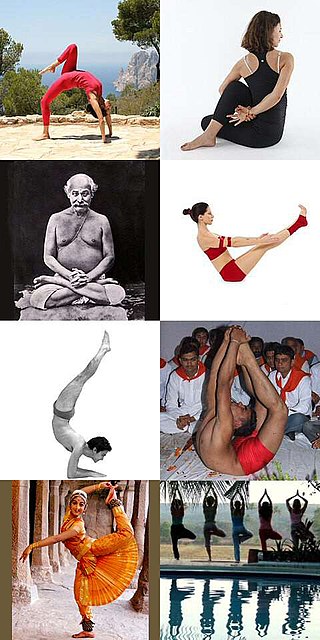
An āsana is a body posture, originally and still a general term for a sitting meditation pose, and later extended in hatha yoga and modern yoga as exercise, to any type of position, adding reclining, standing, inverted, twisting, and balancing poses. The Yoga Sutras of Patanjali define "asana" as "[a position that] is steady and comfortable". Patanjali mentions the ability to sit for extended periods as one of the eight limbs of his system. Asanas are also called yoga poses or yoga postures in English.

Pashchimottanasana, Seated Forward Bend, or Intense Dorsal Stretch is a seated forward-bending asana in hatha yoga and modern yoga as exercise. Janusirsasana is a variant with one knee bent out to the side; Upavishthakonasana has the legs straight and wide apart.
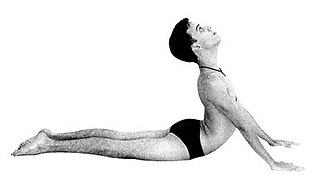
Bhujangasana or Cobra Pose is a reclining back-bending asana in hatha yoga and modern yoga as exercise. It is commonly performed in a cycle of asanas in Surya Namaskar, Salute to the Sun, as an alternative to Urdhva Mukha Svanasana, Upward Dog Pose. The Yin Yoga form is Sphinx Pose.
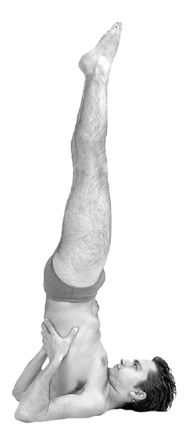
Sarvangasana, Shoulder stand, or more fully Salamba Sarvangasana, is an inverted asana in modern yoga as exercise; similar poses were used in medieval hatha yoga as a mudra.

Dhanurasana is a back bending asana in hatha yoga and modern yoga as exercise.

Halasana or Plough pose is an inverted asana in hatha yoga and modern yoga as exercise. Its variations include Karnapidasana with the knees by the ears, and Supta Konasana with the feet wide apart.

Viparita Dandasana or Inverted Staff Pose is an inverted back-bending asana in modern yoga as exercise. It may be performed with both feet on the ground, or with one leg raised straight up.

Vajrasana, Thunderbolt Pose, or Diamond Pose, is a kneeling asana in hatha yoga and modern yoga as exercise. Ancient texts describe a variety of poses under this name.

Virasana or Hero Pose is a kneeling asana in modern yoga as exercise. Medieval hatha yoga texts describe a cross-legged meditation asana under the same name. Supta Virasana is the reclining form of the pose; it provides a stronger stretch.
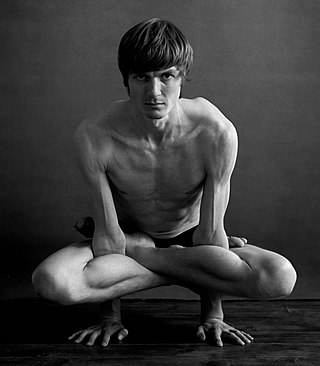
Kukkutasana, Cockerel Pose, or Rooster Posture is an arm-balancing asana in hatha yoga and modern yoga as exercise, derived from the seated Padmasana, lotus position. It is one of the oldest non-seated asanas. Similar hand-balancing poses known from the 20th century include Pendant Pose or Lolasana, and Scale Pose or Tulasana.

Kapotasana or Pigeon Pose is a kneeling back-bending asana in modern yoga as exercise. Asanas based on One-legged King Pigeon pose, Rajakapotasana, are also sometimes called "Pigeon".

Matsyendrasana, Matsyendra's Pose or Lord of the Fishes Pose is a seated twisting asana in hatha yoga and modern yoga as exercise. The full form is the difficult Paripurna Matsyendrasana. A common and easier variant is Ardha Matsyendrasana. The asana has many variations, and in its half form is one of the twelve basic asanas in many systems of hatha yoga.

Koundinyasana, or Sage Kaundinya's pose, is a hand-balancing asana in modern yoga as exercise. It may be performed with both legs bent, or with one leg over the supporting arm, the other leg straight . Eka Pada Galavasana has one leg bent, the foot hooked over the opposite arm under the body.
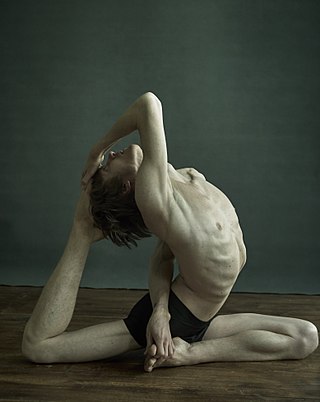
Eka Pada Rajakapotasana, Rajakapotasana, or [One-legged] King Pigeon Pose is a seated back-bending asana in modern yoga as exercise. The Yin Yoga form of the asana is named Swan Pose, while the Aerial yoga variant, supported in a hammock, is called Flying Pigeon Pose. The basic pose is described in the 20th century by two of Krishnamacharya's pupils, Pattabhi Jois and B. K. S. Iyengar; several other variants have been created. It is one of the yoga poses often used in advertising to convey desired qualities such as flexibility and grace.
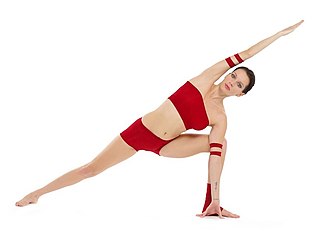
Utthita Parshvakonasana, Extended Side Angle Pose, is an asana in modern yoga as exercise. It is first described in 20th century texts.

Krauñcāsana or Heron pose, also written Krounchasana, is a sitting asana in modern yoga as exercise.
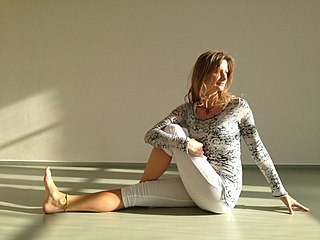
Marichyasana is a sitting twist asana in modern yoga as exercise, in some forms combined with a forward bend.

The standing asanas are the yoga poses or asanas with one or both feet on the ground, and the body more or less upright. They are among the most distinctive features of modern yoga as exercise. Until the 20th century there were very few of these, the best example being Vrikshasana, Tree Pose. From the time of Krishnamacharya in Mysore, many standing poses have been created. Two major sources of these asanas have been identified: the exercise sequence Surya Namaskar ; and the gymnastics widely practised in India at the time, based on the prevailing physical culture.
{{cite book}}: CS1 maint: multiple names: authors list (link)